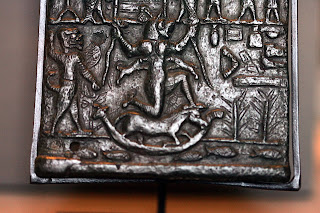Weapon: The last of Hope's second tier weapons and his ultimate
Appearance: Final Fantasy XIII
Tezcatlipoca from the Borgia Codex. Note the missing foot.
Hresvelgr
From Norse mythology. Hresvelgr is mentioned in the
Vafþrúðnismál of the Poetic Edda. In the form of a great eagle the giant Hresvelgr sits at the edge of heaven. And from his wings come the northern wings. The name itself means 'corpse-eater'
The Vathruthnismol
can be found
here, at Sacred-Texts.
Tezcatlipoca
From Aztec mythology. His name means 'smoking-mirror' in the Nahuatl language. Obsidian, which was used to make mirrors, was one of the items under the god's domain. Like many Aztec gods it is very difficult to pin down depictions of Texcatlipoca in art. He does seem to like dark banded face paint and wielding club and shield.
Tezcatlipoca appears in several creation myths where he is often with Quetzalcoatl, his brother at times. These two gods don't tend to see eye to eye. In one creation myth Tezcatlipoca became the first sun to light the mortal world. Unfotunately, as he was a god of the night, he didn't do a very good job of it. So his brother knocked him out of the sky and took his place as the second sun. Over time the humans of the world lost their peity and Quetzalcoatl stepped down as the sun. The rain god Thlaloc became the next sun. Tezcatlipoca stole his wife who, as a goddess of sex and flowers, was probably quite the looker. As any cheated husband might do Thlaloc wallowed in grief causing the world to flood both with water and fire. Tezcatlipoca then instated another new wife as the next sun. Apparently he makes for a lousy husband as this wife found out he never really loved her and so drowned the world in tears of blood. Quetzalcoatl eventually got another god, Huitzilopochtli to become the fith and final sun which we still know today.
Naberius
From Johann Weyer's 16th centuary demonology,
Pseudomonarchia daemonum. Naberius is a marquess of hell who takes the form of a crow. He specializes in teaching men rhetoric for the price of their dignity and honor.
Caladrius
From Greek and Roman mythology. It is said to be a pure white bird that resides in royal house holds.
Nue
From Japanese mythology. The usual depiction of this yokai is of a chimaera like beast. It sports the face of a monkey, the body of a tanuki, tail of a snake and feet of a tiger. In the
Heike Monogatari, which describes this fabulous beast, it says that this creature
has the voice of a Nue bird. The actual Nue was a 'monstrous' bird that terrorized the palace until Yorimasa shot it. A normal, if anoyying, bird isn't as memorable as a fantastical chimaera.
The Nue in its fantastical appearance

















































